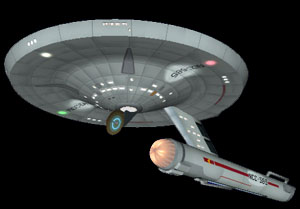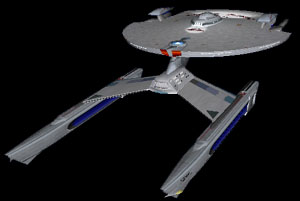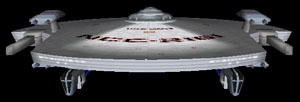
Hermes – fore ventral port quarter
Previous to the introduction of the first Fleet Scout, the vast majority of scout vessels were single-person or small-crew vessels charting the Void by flitting from star system to star system and running quick scans on what they found, and transmitting their findings back to brokers or agents working on their behalf to sell this information to bidders seeking certain types of planets. Starfleet scouts and outriders followed this pattern, and their small vessels were also used for espionage and tactial reconnaissance missions where their small sensor signature and size would allow them to slip past the notice of their opponents. In this repect, these vessels were scouts in the truest sense of the word in that they had no special sensor capability, they could simply slip in where no one would notice, and report back with their findings.
However, the Four Years War of 2241-2245 revealed to Starfleet just how many holes their deep space sensor nets had, and how easy it was for a belligerent force to blind them further by destroying the sensor cabability of fixed installations. It was realised that mobile sensor platforms mounting sensor packages that could see farther than standard starships sensors was a desirable and useful asset to have, in the wake of a first strike that disabled many of their fixed positions; these vessels could then be positioned to provide early warning of impending attacks. Further, that this kind of vessel accompanying a task force would allow greater situational awareness and strategic reach.
Thus the large, or "Fleet" scout was envisioned as a vessel that would meet the following requirements:

Hermes – fore ventral port quarter |
With these requirements in hand, Starfleet Division hit upon the idea that the basic hull of an escort-class vessel would fit the bill nicely in terms of speed, mission endurance, crew comfort, and space for the proposed equipment loadout. Since this proposed Fleet Scout's mission profile precluded combat, heavy weapons were to be omitted – thereby freeing up power for the sensor systems – and primary weapons were needed for self-defence only and thus were to be limited in number.
By taking this approach, Starfleet ensured a 78% commonality in escort-class construction, simplifying procurement chains and reducing the resource expenditure. In this manner the Fleet Scout was born in the form of the Hermes class, introduced into service in 2257.
Named for an ancient Saurian tribe of trackers and hunters, this class of vessel is currently [2285] the ultimate development of the “fleet scout” concept first embodied by the Hermes class in the late 2250s. With a mission profile lineage that includes the unsuccessful Soyuz class ELINT cruiser, the uprated Hermes class, and its Monoceros class variant, this vessel combines and adds onto all these design elements for a ship with superior capabilities for the 2280s and beyond.

Trista – aft dorsal starboard quarter note the shuttle bay at the base of the neck |
The Trista class takes the basic uprated Hermes class layout; with its full-sized primay hull saucer there is plenty of room for Signals Intelligence (SIGINT) and Cryptography laboratories, the massive computer facilities that make sense of all the incoming data, and comfortable quarters and receational facilities for the crew manning them.
The Trista class dispenses with the Hermes class' single nacelle and instead mounts the far more fuel-efficient twin warp nacelle “tuning fork” arrangement of the Soyuz class. This allows for a moderate increase in top speed but more importantly far greater range for less wear and tear on parts, reducing maintenance needs and the Time Between Component Failure (TBCF) on a vessel purpose-built for extended duration missions in uncharted territory far from the nearest starbase.

Trista – fore dorsal note the massive sensor array superstructure |
Where the Trista class truly comes into her own is in her sensor array configurations. Mounting an improved combination sensor suite developed from both the Monoceros class' OC5889S active sensor aray and the Soyuz class’ massive OC3109W outboard passive sensor arrays, the Trista class is equipped for any sensing eventuality. Arranged more compactly and fitted directly into the hull to increase warp-field efficiency, two OC6352W very long range passive sensor arrays are mounted in the forward saucer cut-out quarters, port and starboard. Their large surface area and the power of an escort-class warp reactor allows them an unparalleled sensitivity for the detection of both subspace & realspace communications signals and faint warp-field emissions. Four OC6273T very long range active sensor arrays are mounted above and below the forward saucer cut-out quarters, port and starboard. Usable in both interstellar and orbital ranges, these sensors are at the bleeding edge of Federation scientific and technological excellence.
To create more space for facilities such as crew quarters, recreation areas, laboratories, and computer processing hardware, the standard internal shuttlebay of the previous classes is dispensed with and a dedicated shuttlebay is mounted at the base of the dorsal neck, which also incorporates the Trista's multiple probe launchers.
As is standard practice for Fleet Scout classes a photon torpedo armament is omitted, and the typical saucer complement of six (6) Type-VII banks of twinned dorsal/ventral phaser emitters is reduced to the fore emitters only. In the Trista's case this is supplemented by two single-emitter Type-VII phaser banks, one each on the dorsal and ventral surfaces of the shuttlebay.
As a scout class expected to transition long distances of interstellar void, the physical structure of these ships are specially reinforced for extended duration at high warp speeds. Their structural integrity field is rated to heavy cruiser levels, and their emergency speed of warp 10.63 (Cochrane scale, 1200c) can be maintained for 48 hours. Their flank speed of warp 10 (Cochrane scale, 1000c) can be maintained for ten days, and their maximum safe (i.e. indefinite) cruise speed is warp 8.5 (Cochrane scale, 614c). Compare this to the Constitution class heavy cruisers, whose equivalent max safe speeds are warp 10, warp 9.5, and warp 8 respectively for Emergency, Flank, and Max Cruise.
This class of twenty (20) vessels is named after various ancient tribal units from worlds across the Federation renowned for their tracking and navigational abilities.